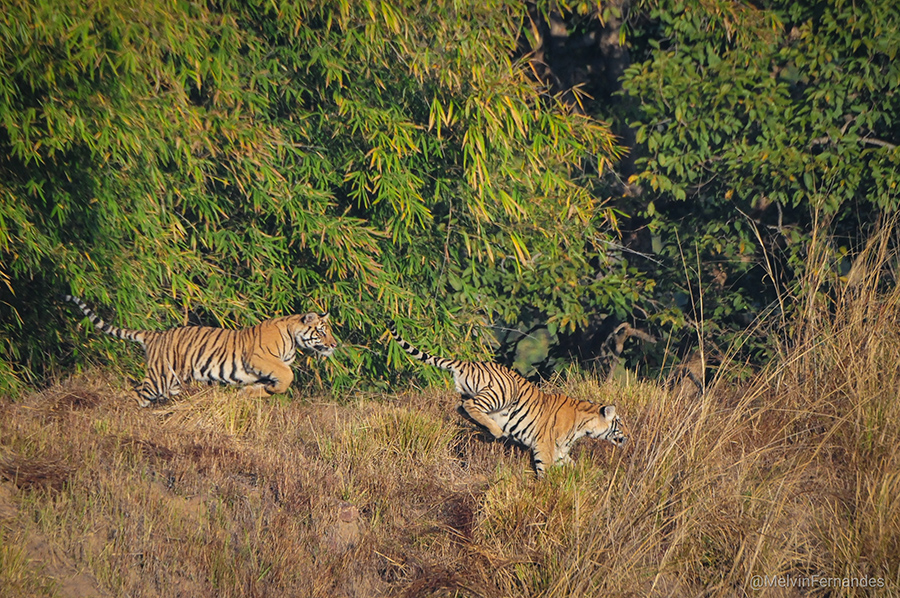
About Bandhavgarh Tiger Reserve
Situated in the Umaria district of Eastern Madhya Pradesh, Bandhavgarh National Park is known for its conducive geographical construct. It is the main attraction for wild lovers in the Central India region. It is spread in an area of 450 Square Kilometers and is known for its sprawling green extension of tall trees grown in tropical forest. This tiger reserve also accommodates more than 250 species of birds and mammals. Its flora and fauna includes tall grasslands and thick Sal forest
Bandhavgarh National Park is divided in four zones out of which three are major attraction. These are named – Tala, Bamera and Magdi. Among these the Tala zone offers more opportunities of catching the sight the big cat in all its glory. The park authorities in consultation with forest officials are trying to develop the other zone, Magdi Zone too in a way to make it a thriving abode for the tigers so that the visitors can spot tigers in this zone too.
The forest officials are also taking some proactive measures like organizing the elephant shows to increase the opportunity of spotting the royal predators in the Magdi zone.
Besides serving as the abode to white tigers this park also provides shelter to several other Indian wild species like Langurs, Cheetals, Bison and Sambars.
Flora and Fauna
Flora
The beautiful woods of Bandhavgarh attract visitors who are interested in being in the lap of nature and unadulterated entertainment. It attracts numerous tourists from all over the world. The park remains closed during the monsoon season as it is at its best during spring season. The ideal time to explore wildlife in the park is from January to March.
The scenic beauty of Bandhavgarh National Park’s landscape and picturesque cliffs, 32 hills, plateaus and meadows are things to behold. Being in the tropical region it has got forests of Sal forest and Bamboo and tal trees in abundance.
The fertile riverbanks of Bandhavgarh have lush vegetation with 300 species of flora. Some of the major species are as follows:
Saj (Terminalia tomentosa)
Tendu, Arjun (Terminalia arjuna)
Dhaora (Anogeissus latifolia)
Palas (Butea monosperma)
Amla (Emblica officinalis)
Jamun (Blackberry) (Syzygium Cumini)
Mango (Mangifera indica)
Khajur (Phoenix sylvestris)
Ber (Zizyphus Mauritiana)
Salai (Boswellia serrata)
Babul (Accasia nilotica)
Dhok (Anogeossis pendula)
Banyan (Ficus benghalensis)
Dhak or Chila (flame of the forest) {Butea monosperma}
Kadam (Authocephalus cadamba)
Khair (Accacia catechu)
Lagerstroemia
Bamboo
Boswelia
Madhuca
Pterocarpus
Kakera (Flacourtia indica)
Fauna
Bandhavgarh National Park is mostly visited by the tourists from worldwide for the white royal predators. It also has a huge list of other animals and birds that can be spotted in the park which includes Nilgai, Sambar, Barking Deer, Gaur, Chausingha, Wild Boar, and Chinkara. The wildlife lovers will also be happy to witness Leopards, Sloth Bear, Striped Hyena, the Asiatic Jackal, Bengal Fox, Ratel, Grey Mongoose, Jungle Cat, Spotted Deer, Dhole, Palm Squirrel, Small Indian Civet, Little Grebe and Bandicoot Rat.
The species of birds found abundantly are Egret, Sarus Crane, Adjutant, Crested Serpent Eagle, Black Kite, Black Vulture, Common Peafowl, Egyptian Vulture, Dove, Red Jungle Fowl, Indian Roller and Parakeet. Grey Hornbill, White Breasted Kingfisher and Common Teals are some other species of birds spotted in the park.
The Bandhavgarh part is also home to reptiles. One can easily get the sight of reptiles like Cobra, Viper, Krait, Rat Snake, Turtle, and Python. The part also houses a variety of lizards including Varanus.
